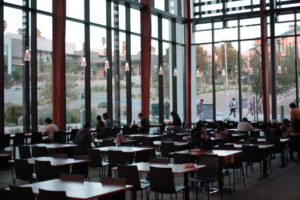
Spend five minutes in UC Riverside’s Glasgow dining hall and see five different signs about food waste. Reducing food waste is an important and valid goal, as 130 billion meals get thrown away every year. The University offers the solution of students only helping themselves to what they think they can finish. This seems logical, and UCR appears proud of its progress, with the UCR Dining Service’s page on sustainability currently boasting a 17-ton drop in food waste by residential restaurants in the past year. But when it turns out that drop is only 7.5% and the school still throws away approximately 209 tons of food every year, larger measures should be taken.
Back in the dining hall, a sign on the way out tells students only to take one dessert or one fruit out. Many students often complain about not being able to grab an extra sweet treat, and while this appears to be a trivial issue, there is a larger implication and issue behind this sign. One of the worst and quietest epidemics in the U.S. is food insecurity, according to a survey in 2021 that reported 39% of adults in California experience this.
College students are one of the most affected communities, with about 23% of college students currently experiencing food insecurity. Yet, very little effort addressing this issue has been made. During the COVID-19 pandemic, Supplemental Nutrition Assistance Program (SNAP) benefits were extended to college-age students. In the 2019-2020 academic year, 11.8% of all UC students were enrolled in this program. However, these benefits ended June 10 this year, leaving many college students without options.
The meal plans offered by UC Riverside are the most affordable and convenient choices for students. The standard plan, Highlander 150, gives students 150 swipes into any of the all-you-care-to-eat dining halls. This averages to two swipes per day. While Highlander 150 works for many students, it is still less than the typical minimum of three meals a day. Weight and physical activity can further inflate this number, with many people needing snacks between meals to feel properly fueled.
If so much food is being thrown out by the dining halls every year, it seems like the University would want students to take what they will eat later. However, a great deal of enforcement and effort is devoted to preventing this from happening. In addition to the sign near the exit, staff members at the entrance are positioned to stop anyone who tries to violate this policy. Obviously, no one would want someone to enter the dining hall, take all the desserts and then leave. Still, given that many college students struggle economically and so much food is thrown out of the dining hall every year, the strict no-take policy should be reevaluated.
In order to prevent an excess amount of food from disappearing, the University should also take measures to ensure only meal-sized portions are taken outside of the dining hall. Georgetown University, for example, provides students with reusable boxes to take their leftover food instead of just throwing it away. This program ensures that if students get hungry later but cannot come to the dining hall, they still have something to eat.
Students cannot function to the best of their abilities, physically or psychologically, on an empty stomach and with poor nutrition. It is the university’s job to promote the success of all its students, and UC Riverside, as a strong academic institution, should facilitate this. For four years in a row, U.S. News ranked UCR first in social mobility among public universities. To continue with this legacy, the University should take a step towards ensuring no student goes hungry and change the dining hall policy.







